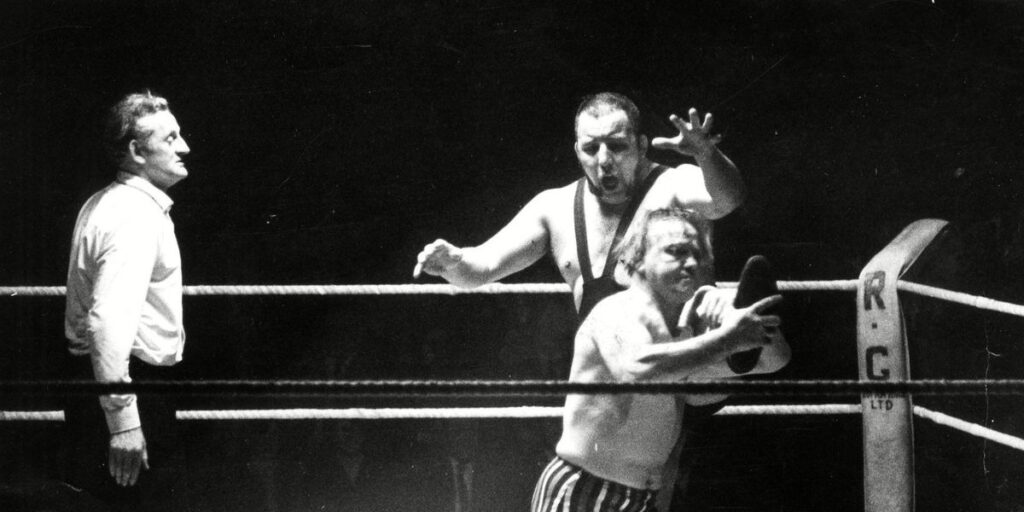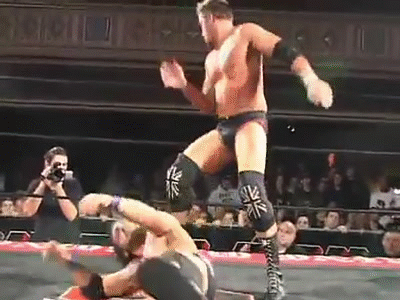Les Kellett was a paradox.
Inside the ring, he was a comedic genius, captivating millions with his antics and earning the title “Clown Prince of Europe.”
Outside of it, he was known as a fierce, no-nonsense individual who commanded respect.
Born in Bradford, England, Kellett’s journey from post-World War II wrestling hopeful to one of Britain’s most beloved and enigmatic stars is a story of contrasts.
As television brought British wrestling into living rooms across the nation, Kellett’s unique blend of slapstick comedy and hard-hitting technical skill made him a household name, influencing generations of wrestlers around the world.
From Wartime to Wrestling Stardom: Les Kellett’s Early Years

Les Kellett was born in 1915 in Bradford, England.
Well, he probably was. The date of his birth was largely a secret throughout his life, and his age a mystery.
This was mainly due to his wrestling career. He was clearly much older than the rest of his peers once wrestling made it to TV, and Kellett didn’t want to be left behind and miss out on the money coming in.
It wasn’t until his obitruaries came out following his death in 2002 that anybody knew he was born in the midst of World War 1.
Unluckily for him, the second World War would affect his goals of becoming a wrestler.
He trained to become a wrestler before war broke out, and even made his debut in 1938. However, his career was put on hold as he joined the Merchant Navy during World War II.
His actual involvement in the war is questionable. Some sources claim he was a regular troublemaker in the merchant navy, and was court martialed numerous times during his service.
Howevers, others seem to think he was actually a conscientious objector, refusing to fight for his country during a time where millions of young men were conscripted during wartime.
“He wouldn’t soldier in the wartime,” Max Crabtree, the brother of Shirley “Big Daddy” Crabtree, said to Simon Garfield in The Wrestler.
“It was his personality. He spent a lot of time in the nick (prison).” Max Crabtree said.
“He wasn’t a thief or anything like that – it was him going against the establishment. He were full of fire.”
The actual truth is shrouded in mystery, which was just the way Kellett like it. Keeping his past a secret helped hide his age when he finally broke into professional wrestling in the 1940s.
He tried out with promoter Norman Morrell, and had to fight Arthur Belshaw in a “shoot” match to earn a spot on his shows.
In “Have A Good Week… Till Next Week” by John Lister, he writes about how Les Kellett had his finger bent back by Belshaw during the fight.
When told to submit or risk it being broken, he told his competitor to break it. He was not going to submit.
That got Les Kellett the job with Morrell, who would later go on to help from Joint Promotions in 1952 and help catapult him to television stardom.
This incredible disregard for his own safety and incredible pain tolerance was something Kellett became famous for, at least backstage. Inside the ring, he was a much different person entirely.
This was after the wrestling world changed from its outlaw ways of “All-In Wrestling” to the Lord Mountevans Ruleset that changed the sport.
Learn how the Lord Mountevans Rules revolutionised British wrestling
Les Kellett’s Unique In-Ring Style: Comedy Meets Technical Mastery
“The Clown Prince of Europe” was the perfect nickname to describe Les Kellett’s wrestling style and persona in the ring.
In the ring, he was pure comedic genius. Kellett was a throwback to Victorian era music hall performers, with a pantomime-style of physical comedy.
His movements were erratic and unexpected, which had the crowd in stitches. He was deceptivly agile, given his short, stocky and flabby frame.
The moves he performed in the ring were unorthadox. Kellett would buck wrestling tropes, like stumbling away at the last minute when a wrestler ran towards him, akin to Samoa Joe’s “walk away” move.

He’d counter a hold by stamping on his opponents foot, or back away in mock fear from a lock up before hitting his trademark headlock.
It was pantomime stuff, and he perfected it.
Les Kellett looked absolutely nothing like a modern-day wrestler. His hair stood up like Boris Johnson in a wind tunnel, and his pale body was not that of an athlete.
However, his technical skills and aggression was a in complete contrast to his look.
Part of the comedy was how this unassuming old looking man could fly around the ring like the best of them, before falling on his backside in increasingly unique ways.
However, he didn’t always wrestle this way. Les Kellett started out as a straight-laced shooter, like most others in the 1950s.
However, after a particularly violent encounter with Sheamus Dunlevy in the late 1950s. Kellett felt he was taking too much punishment, and began ducking Dunlevy’s erratic punches.
With each duck, the crowd began to chuckle, chortle and giggle. He took this skill and ran with it, becoming one of the greatest comedy wrestlers of all time.
Les Kellett Inspired Numerous Modern Day Wrestlers

Les Kellett’s comedy stylings have lasted the test of time.
Numerous wrestlers from the UK and abroad have been inspired his in-ring antics, citing him as an inspiration for them in the ring.
One of the most prominent is All Elite Wrestling’s Colt Cabana. The former NWA World’s Heavyweight Champion is an artist in the world of both comedy and technical wrestling, something Kellett was an absolute master of.
The American cites Les Kellett, as well as another British wrestler called Catweazle, as his two biggest inspirations in wrestling.
“I’m always very loud about two guys who I consider my biggest influences – one guy named Les Kellett and one guy named Catweazle.” Cabana told Vice.
“To sum it up a little bit, the British style of wrestling in the 60s and 70s was very serious, and these guys were comedy wrestlers. But they were doing it in the style of serious wrestling and people still believed they were wrestling.”
“There was something about the way they did it where they were still taken seriously within the context of wrestling. Every match you watched of them, they were getting these huge applause breaks for laughs and jokes within their wrestling matches.”
Les Kellett’s influence on Colt Cabana in clear to see. He melds the American style with classic British comedy perfectly, and is one of the few people keeping the style Kellett perfected alive today.
Another AEW star, Nigel McGuinness, was directly inspired by Les Kellett.
Despite being English, McGuinness didn’t grow up on Kellett or World of Sport. He was a WWE fan, long after the days of “The Wrestling” being the king on ITV.
However, later viewings of some historical tapes inspired one of his most famous moved.
McGuinness’ rebound lariat, which is known as “The Nigel” now, came directly from a Les Kellett creation.

While McGuinness rebounds into a lariat, Kellett instead rammed his skull into the chest of his opponent.
It is a great alteration of the move, although it was directly inspired by Les Kellett. McGuinness admitted so on Twitter all the way back in 2015.
Orange Cassidy also takes several cues from the Crown Prince of Europe.
His entire comedy act, which seems him feign disinterest before tying his opponent up in knots, seems to come straight out of the Les Kellett playbook.
The Englishman’s influence over wrestling in Britain and across the world is huge, and with his matches becoming more available to watch again on YouTube, that will only grow.
Another American star, the masked Ninja Mack, is another wrestler who is a big fan of Les Kellett.
From a worker’s perspective, the wrestlers I really enjoy watching are Les Kellett and Tom Pritchard.” He told Monthly Puroresu.
“Les Kellett, watching all those wrestling matches from the seventies and the eighties. The way Les Kellett could present basic moves in a ring, but make everything still so good and entertaining at the same time. Those guys are huge influences.”
The Peak of Les Kellett’s Career: Television Stardom in the 1960s and 1970s
Les Kellett started wrestling properly in the 1940s, after the war in Europe had ended.
He quickly found that the comedy style suited him. Kellett stuck with this act for his entire career.
While his matches were all broadly the same, it didn’t matter. He was like a music hall act, travelling the country with his tightly-planned performance.
Given that the most any wrestler was on TV a year was six times (according to William Regal), he never got stale.
Usually TV was the deathknell of a travelling act like his. Once you’d seen it once, you’d seen it. But Les Kellett was different, and he kept fans laughing for decades.
He became a big deal in wrestling in the 1950s, before the advent of television. He was reportedly making £50 a week during this time, which was equivalent to around £1500 in today’s money.
This may seem like big money, but it wasn’t enough. Les Kellett opened up a transport cafe, named Terminus, near Thornton where the trains terminated.
In the words of Max Crabtree, “It was a shithole“.
I’ll leave that there.
His star rose even higher when wrestling was put on the television for the first time.
Les Kellett quickly became a regular on the FA Cup Final wrestling show. Before the biggest football match of the year, ITV broadcast a wrestling show which often outdrew the football itself.
Between 1969 and 1972, he wrestled in three of the four FA Cup Final events. Kellett won all three, in undoubtably hilarious fashion.
This, alongside the advent of World of Sport bringing the wrestling to TV on Saturday’s every week, brought him fame like he never expected.
There was a saying back in the day – everything stops at four O’clock. This was when the wrestling was on. The country stopped to see the fights, with Kellett an absolute favourite for kids and Grandmas alike.
In the 1970s, he was one of the top stars on the show. Les Kellett was one of the most popular wrestlers, and up to 20 million people a week would tune in to see him fight the likes of Mick McManus and Kendo Nagasaki.
The most amazing thing about Les Kellett was simply how old he was when he was on top. Being born in 1915, he would’ve been in his 50s during his run on top. He looked every day of it, but still performed at a high level in the ring.
His wrestling style meant that he didn’t take many bumps, with crowds more interested in seeing him make a fool of himself and his opponent, as opposed to killing himself in the ring.
One could compare him to Minoru Suzuki, who has found a way to prolong his career while taking care of his body, wrestling a less-intensive style.
Les Kellett’s star power was huge. Tony Walsh called him “the biggest draw in the country”, likening him to Big Daddy’s drawing power in the 1970s and 1980s.
He Even Trained Celebrities To Wrestle, Including Sir Jimmy Saville
Kellett is said to have trained Sir Jimmy Savile to become a wrestler. While he is now a disgraced paedophile, in the 1960s Savile was a big star when he decided to step into the ring.
However, Kellett’s involvement in his training was likely minimal. He started training back in 1964, at the Athletic Institute in Hunslet.
This was advertised as being run by the World of Sport star. However, the Clown Prince of Europe was only a part-time trainer and had very little involvement in Jimmy Savile’s training.
That honour went to Jack Taylor, a relative of Kellett who really never made his mark on the wrestling business.
Read more about the notorious Jimmy Savile taking the wrestling world by storm
Behind the Curtain: Les Kellett’s Tough and Controversial Persona
So far in this article, we have waxed lyrical about the genius of Les Kellett inside the ring.
However, his personality behind the scenes was one of fear and loathing. Kellett was a sullen, aggressive personality, who was the opposite of his character on TV.
There was “fun-loving” Kellett backstage. He sat alone, grunting to himself and picking fights wherever he could.
Everyone knew he was a “hard man”, and knew not to try him. Even when Kellett was sat in nothing but his wrestling boots and hat, nobody dared question why his balls were hanging out.
If you did, there’d be trouble.
You’d think that nobody would be afraid of a comedy wrestler. But Kellett was only able to pull off the hilarious feats he did because he was tough.
Les Kellett was one of the toughest wrestlers around. And the worst part was, he knew it. Nobody could mess with him, so he thought he’d mess with them first.
“To watch him work in the ring, you thought ‘Oh he’s funny, isn’t he lovely?’.” ‘Mr TV’ Jackie Pallo said about Les Kellett in a 1997 documentary.
“Being there with him, I would sooner go in there with three wrestlers than wrestle Les Kellett.”
“Because if Les was in a bad mood – bye bye.”
It didn’t matter if you were a veteran of the ring, or a bright-eyed youngster just starting out. Kellett hated you all the same.
Billy Abbey told a story in The Wrestling about Les Kellett giving a young wrestler a tryout in Dale Martin’s Gym in Brixton.
He recalled that 40 seconds into the tryout match, Kellett has disclocated his opponents shoulder, refusing to let go as he screamed in pain.
Les Kellett also had an extremely high pain threshold, which only added to his aura as a hard man. Many even questioned if he felt pain at all, given some of his antics.
The most bizarre and painful-sounding thing he ever did was described by Welsh legend “Exotic” Adrian Street. Street called him a “very nasty man”, while explaining his “feats”, if you can call them that.
He described how Kellett dealt with an infected finger. The Welshman told Simon Garfield that Kellett, who kept pigs behind his cafe, was bitten one day by one of the hogs.
This caused a horrendous infection, which caused his hand to swell up “like a boxing glove”. However, being the stubborn mule of a man he was, Kellett decided to head to the wrestling instead of the hospital.
However, he couldn’t wrestle with it in that state. He employed his opponent that night stamp on his hand, which he did after a lot fo convincing.
The wrestler stamped on Les Kellett’s hand, as pus, blood and blood shot from it and covered the floor.
Anybody who has had an infected finger can imagine the extraordinary pain he must’ve felt, but Les Kellett did not even flinch.
As Street put it, “he had to be the centre of attention, did Les”.
You can learn more about why Les Kellett was hated behind the scenes by clicking the link.
A Wrestling Icon’s Final Days: Les Kellett’s Retirement and Legacy
Les Kellett wrestled until he was 68-years-old, in an astonishing career that went from the 1950s until 1983 (not counting his brief stint in 1938).
He was sick of working for Joint Promotions by 1975, so the 60-year-old decided to quit and work the live event circuit.
At that point, he was a household name. Les Kellett didn’t need TV to help sell tickets, as any show with him at the top of the bill was sure to draw the punters in.
This allowed him to pick and choose who he wrestled, although it went both ways. His reputation as a tough man to work with preceeded him. Sometimes, wrestlers would simply no-show if booked against Kellett.
In the year 2000, a now-retired Les Kellett moved into a nursing home in Ilkay. This was the same year that Dave Barrie passed away.
He travelled with the young wrestler for many years, who turned out to be his real-life son. His unexpected death hit Kellett hard, who quickly went downhill.
Les Kellett died in 2002 at the age of 86. He has gone down as a legend of the ring, and arguably the greatest comedy wrestler of all time.
Max Crabtree once compared Les Kellett to Pagliacci the clown, which seemed fitting.
The Clown Prince of Europe was a different man inside the ring than out of it. He had the fans in tears at his antics, laughing hysterically as bumbled around the ring like a drunkard.
He had them in tears backstage too. But that was out of fear or pain. Kellett didn’t like anyone, and knew that nobody liked him.
Who knows what hardened him during his life that made him so untrusting of his fellow wrestlers? His past is full of secrets, and with no tell-all book like Jackie Pallo and Kendo Nagasaki, we likely will never find out what hardened him to the world.

